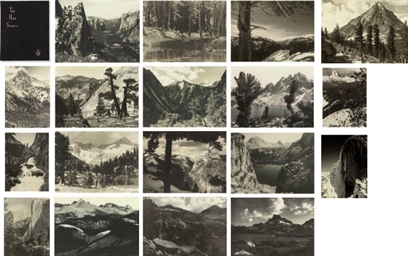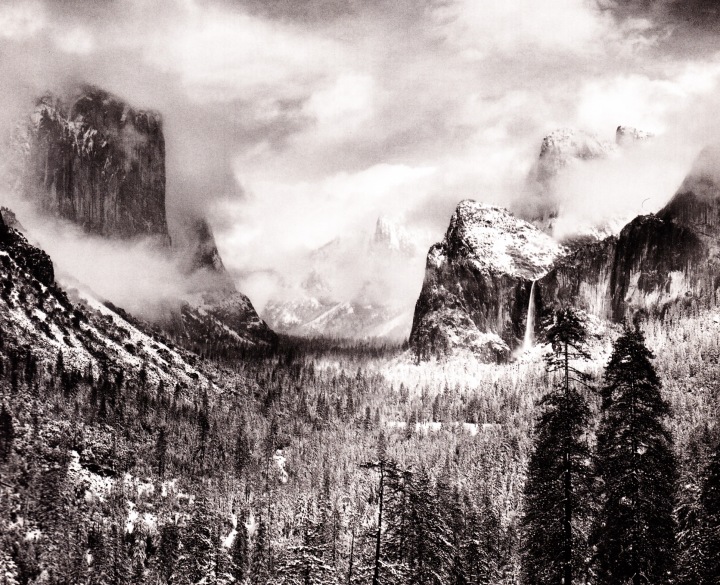Saturday, February 9, 2013
Ansel Adams at 100
The Museum of Modern Art presented the final opportunity to see Ansel Adams at 100, on view from July 11 to November 3, 2003, at MoMA QNS, the last venue on the international tour. Although Adams’s work has been more widely exhibited than that of perhaps any artist in the twentieth century, his oeuvre has not been fundamentally re-evaluated since his death in 1984. This centenary exhibition presents an aesthetic reappraisal of Adams (1902–1984) as an artist and working photographer by bringing together 113 of his finest photographs, represented by exemplary prints drawn from important public and private collections. The exhibition was organized for the San Francisco Museum of Modern Art by guest curator John Szarkowski, Director Emeritus of MoMA’s Department of Photography. Ansel Adams at 100 has been organized with the cooperation of The Ansel Adams Publishing Rights Trust and the Adams family.
The subject of the exhibition and catalogue was Adams the artist.” Ansel Adams at 100 situated photographer’s iconic works, such as
Mount Williamson, from Manzanar (c. 1944)
and Moonrise, Hernandez, New Mexico (1941), within the context of an unexpected and unfamiliar body of photographs, including
North Palisades, from Windy Point (1936)
and Two Dead Trees Against Black Sky, Sierra Nevada (1925). The photographer identified deeply with the culture and geography of the American West. Adams made hundreds of photographs of the American landscape and his pictures, according to Mr. Szarkowski, “have revised our sense of what we mean when we say landscape.” As Mr. Szarkowski states in his catalogue essay, “Adams’s pictures . . . demonstrate that even in the great theatrical diorama of Yosemite, the mountains are no more miraculous than a few blades of grass floating on good water. His pictures have enlarged our visceral knowledge of things that we do not understand.”
Ansel Adams was born in San Francisco in 1902, lived there for 60 years, and spent the last two decades of his life in Carmel Highlands, on the Big Sur Coast. As a youth he first photographed Yosemite Valley with a Kodak Brownie box camera, and Yosemite became the lifelong subject for which he is best known. Starting in 1919, Adams spent much time in Yosemite and the Sierra and served as photographer on the Sierra Club Outings until 1936. The process of Adams’s development as an artist is documented in the proof albums that he made on these outings, three of which are included in this exhibition. In his later life, Adams became an important educator and proponent for the medium of photography, an advocate for the Sierra Club, and America’s best-known environmentalist.
Storm, Yosemite Valley, California, 1938
Photograph by Ansel Adams
© The Ansel Adams Publishing Rights Trust
“I knew little of these basic problems [of environmental conservation] when I first made snapshots in and around Yosemite. I was casually making a visual diary – recording where I had been and what I had seen – and becoming intimate with the spirit of wild places. Gradually my photographs began to mean something in themselves; they became records of experiences as well as of places. People responded to them, and my interest in the creative potential of photography grew apace. My piano suffered a serious rival. Family and friends would take me aside and say, ‘Do not give up your music; the camera cannot express the human soul' _…I found that while the camera does not express the soul, perhaps a photograph can! …Stieglitz's doctrine of the equivalent as an explanation of creative photography opened the world for me. In showing a photograph he implied, ‘Here is the equivalent of what I saw and felt.' That is all I can ever say in words about my photographs; they must stand or fall, as objects of beauty and communication, on the silent evidence of their equivalence.”
-- Ansel Adams
Ansel Adams – photographer, musician, naturalist, explorer, critic and teacher – was a giant in the field of landscape photography. His work can be viewed as the end of an arc of American art concerned with capturing the “sublime” in the unspoilt Western landscape. This tradition includes the painters Albert Bierstadt, Thomas Cole and Thomas Moran, and the photographers Carleton Watkins, Timothy O'Sullivan and William Henry Jackson.
For much of his early adulthood, Adams was torn between a career as a concert pianist versus one in photography; later, he famously likened the photographic negative to a musical score, and the print to the performance. Yet most museumgoers are only familiar with the heroic, high- gloss, high-contrast prints that Adams manufactured to order in the 1970s-80s, coinciding with the emergence of the first retail galleries devoted to photography; as performances, these later prints were akin to “brass bands.” Much less familiar are the intimate prints, rich in the middle tones – the “chamber music” – that Adams crafted earlier in his career.
This show focused on the masterful small-scale prints made by Adams from the 1920s into the 1950s. Already in this time period there is quite an evolution of printing style, from the soft-focus, warm-toned, painterly
“Parmelian prints” of the 1920s; through the f/64 school of sharp-focused photography that he co-founded with Edward Weston and Imogen Cunningham in the 1930s; and, after the War, towards a cooler, higher-contrast printmaking approach.
Several singular examples were included in this exhibition. The extraordinarily rare print of Moonrise, Hernandez is one of the earliest extant – with its light gray (rather than deep black) sky with wispy clouds, it is literally “day and night” when compared to his much more common, much darker, printings from the 1970s and 1980s.
The print of Frozen Lake and Cliffs is considered the finest vintage print extant; it was the announcement for the recent blockbuster show “Ansel Adams at 100,” curated by the late John Szarkowski. Monolith, the Face of Half Dome is represented by two contrasting examples: the vintage 6x8 inch Parmelian print from 1927, and a rare transitional 16x20 inch matte-surface mounted print from the early 1940s which shows Adams first experimenting with scale but not yet consistently committed to glossy paper stock.
Clearing Winter Storm, taken from Inspiration Point, is Adams' most celebrated Yosemite view. The exhibition featured the earliest known vintage print of this seminal image (a 1938 date appears on his original typewritten label), which just surfaced in 2005. Hitherto this photograph had generally been dated “circa 1944”; it is noteworthy that such an iconic image can be re-dated in this manner by a full six years.
Interesting Review - see images referred to here:
''Grass and Pool'' (1935),
''Wanda Lake, Near Muir Pass'' (1934),
''Mount Whitney From the West, Sierra Nevada'' (1932),
''Surf Sequence 3'' (1940),
''Yosemite Valley, Thunderstorm'' (circa 1949),
''Winter Sunrise, Sierra Nevada From Lone Pine, California'' (1944),
''Hopi Butte'' (1936)
More Images Here
TOUR:
The exhibition was previously shown at the following venues: San Francisco Museum of Modern Art (SFMOMA) (August 4, 2001–January 13, 2002); The Art Institute of Chicago (February 20–June 2, 2002); Hayward Gallery, London (July 4–September 22, 2002); Kunstbibliothek, Berlin (October 10, 2002–January 5, 2003); and Los Angeles County Museum of Art (February 2–April 27, 2003). MoMA QNS was the last venue on this international tour.
PUBLICATION:
Marking the 100th anniversary of Adams’s birth, and to coincide with this exhibition, Little, Brown and Company—the exclusive publisher of the work of Ansel Adams—published Ansel Adams at 100. Written and edited by John Szarkowski, this definitive volume on the artist and his work features prints that have been meticulously reproduced for the book under the supervision of Richard Benson, dean of the Yale University School of Art, recipient of a MacArthur Foundation “genius” grant, and a pivotal figure in recent advances in photographic reproduction. Printed on specially made French paper and bound in natural linen cloth with a matching slipcase, the oversized, 192-page book has been designed by the award-winning J. Abbott Miller of Pentagram Design. Featuring 114 tritone and 23 duotone illustrations and a frameable reproduction print of an Adams photograph, complete with facsimile signature, Ansel Adams at 100 is priced at $150. A paperback version of the catalogue is available for $40.








.jpg)





